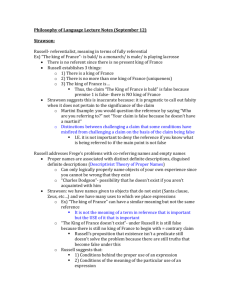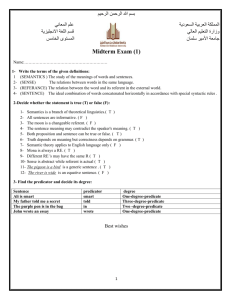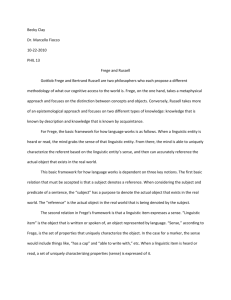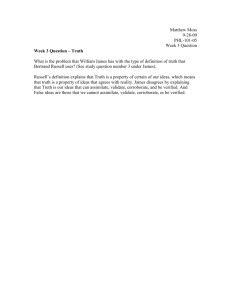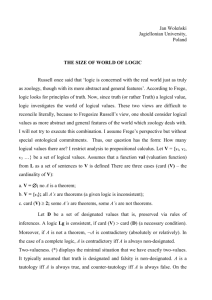Historical Setting
advertisement
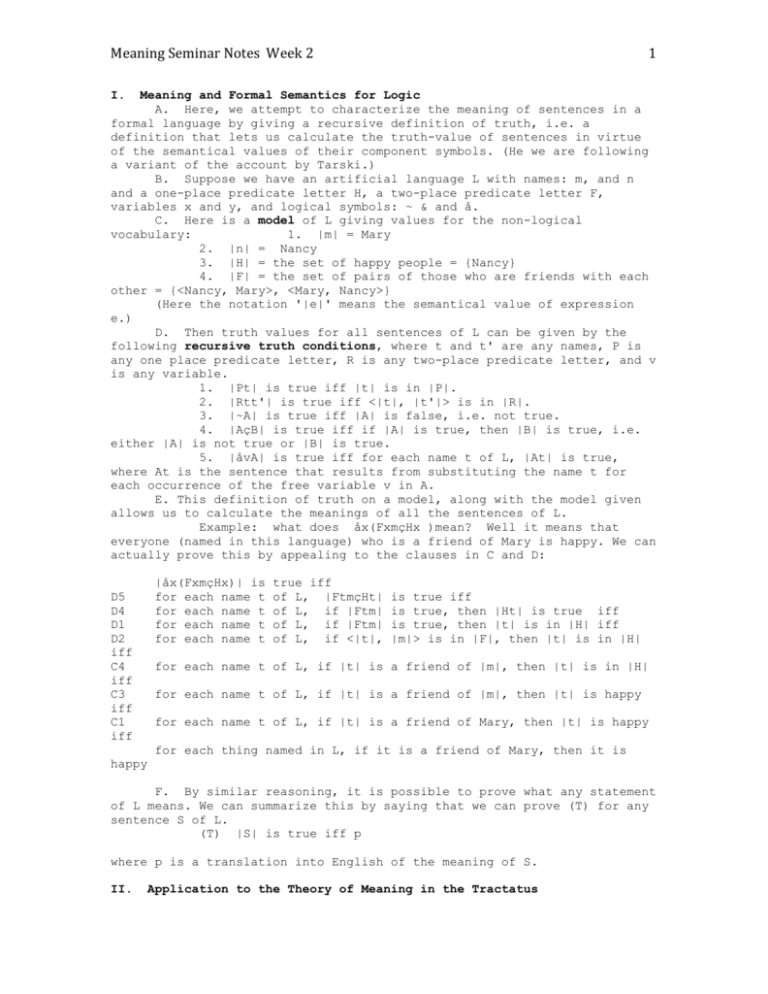
1
Meaning Seminar Notes Week 2
I.
Meaning and Formal Semantics for Logic
A. Here, we attempt to characterize the meaning of sentences in a
formal language by giving a recursive definition of truth, i.e. a
definition that lets us calculate the truth-value of sentences in virtue
of the semantical values of their component symbols. (He we are following
a variant of the account by Tarski.)
B. Suppose we have an artificial language L with names: m, and n
and a one-place predicate letter H, a two-place predicate letter F,
variables x and y, and logical symbols: ~ & and å.
C. Here is a model of L giving values for the non-logical
vocabulary:
1. |m| = Mary
2. |n| = Nancy
3. |H| = the set of happy people = {Nancy}
4. |F| = the set of pairs of those who are friends with each
other = {<Nancy, Mary>, <Mary, Nancy>}
(Here the notation '|e|' means the semantical value of expression
e.)
D. Then truth values for all sentences of L can be given by the
following recursive truth conditions, where t and t' are any names, P is
any one place predicate letter, R is any two-place predicate letter, and v
is any variable.
1. |Pt| is true iff |t| is in |P|.
2. |Rtt'| is true iff <|t|, |t'|> is in |R|.
3. |~A| is true iff |A| is false, i.e. not true.
4. |AçB| is true iff if |A| is true, then |B| is true, i.e.
either |A| is not true or |B| is true.
5. |åvA| is true iff for each name t of L, |At| is true,
where At is the sentence that results from substituting the name t for
each occurrence of the free variable v in A.
E. This definition of truth on a model, along with the model given
allows us to calculate the meanings of all the sentences of L.
Example: what does åx(FxmçHx )mean? Well it means that
everyone (named in this language) who is a friend of Mary is happy. We can
actually prove this by appealing to the clauses in C and D:
D5
D4
D1
D2
iff
C4
iff
C3
iff
C1
iff
|åx(FxmçHx)| is
for each name t
for each name t
for each name t
for each name t
true iff
of L, |FtmçHt|
of L, if |Ftm|
of L, if |Ftm|
of L, if <|t|,
is true iff
is true, then |Ht| is true iff
is true, then |t| is in |H| iff
|m|> is in |F|, then |t| is in |H|
for each name t of L, if |t| is a friend of |m|, then |t| is in |H|
for each name t of L, if |t| is a friend of |m|, then |t| is happy
for each name t of L, if |t| is a friend of Mary, then |t| is happy
for each thing named in L, if it is a friend of Mary, then it is
happy
F. By similar reasoning, it is possible to prove what any statement
of L means. We can summarize this by saying that we can prove (T) for any
sentence S of L.
(T) |S| is true iff p
where p is a translation into English of the meaning of S.
II.
Application to the Theory of Meaning in the Tractatus
Meaning Seminar Notes Week 2
2
A. Things are working out so well for our formal language L that we
are inspired to do the same for English itself. The idea that truth
conditions could help explain how sentences can be about the world goes
back at least as far as Wittgenstein's Tractatus Logico Philosophicus,
which is partly inspired by Bertrand Russell.
B. In the Tractatus, Wittgenstein proposed his picture theory of
how atomic sentences (for example, sentences in L of the shapes Pt and
Rtt') are about corresponding states of affairs. A state of affairs is a
way in which objects might get into a relationship. So, for example, that
Nancy is friends with Mary and that Mary is happy are two states of
affairs. If the state of affairs that Pt expresses exists, then Pt is
true, and otherwise Pt is false. So, using our previous example, since Hm
picks out the state of affairs that Mary is happy, and this state of
affairs does not exist, Hm is false.
C. Once this correlation between atomic sentence and state of
affairs is established, there is nothing more to say about meaning. The
truth conditions for the connectives guarantee that the truth-value of any
complex sentence can be calculated from the values of its parts. Since
this informs us of the truth-value of every complex sentence, we have all
we need to understand it. A complex sentence indicates some truth
function generated by the meanings of its atomic components. It merely
says something complicated about the truth behavior of atomic sentences,
each of which means something about the way the world might be.
D. In a way, this approach is deflationary, since, strictly
speaking, a complex statement does not express a complex state of affairs.
Wittgenstein did not believe there were any complex states of affairs.
(What would a negative, or conditional state of affairs be anyway?) Only
atomic sentences pick out states of affairs, and the meaning of complex
sentences is entirely exhausted by the way in which complex sentence
truth-values depend on the truth-values generated by the meanings of the
atomic sentences.
E. Now all we need to do to give a theory of meaning for English is
to show how every sentence of English can be expressed in the language L,
or some other formal language like predicate logic that has recursive
truth conditions. This idea has been extremely influential in analytic
philosophy. It is attractive because those who object to the idea seem
duty bound to come up with some alternative theory of meaning, and finding
alternatives is difficult.
III.
How to Preserve Ontological Purity
A. This theory is deflationary in another way. One might ask: what
is the meaning of logical expressions like 'not' and 'all'? Does 'not'
refer to Negation, and 'all' to Universality? The above theory provides
an answer by saying that while some expressions like 'Mary' and 'is happy'
are categorematic, meaning they have interpretations or meanings, the
logical connectives are syncategorematic, that is, they do not have
meanings themselves. Instead, they play roles that make meaning
contributions in the context of sentence in which they appear.
B. So if I am asked what 'not' means, I can reply: there is nothing
that 'not' means in itself. It certainly does not mean Nothingness.
Nevertheless, it has a "meaninglike" role or use. The way 'not' works is
to convert any true sentence: A into a false sentence: not A, and vice
versa, end of story.
C. The tactic of declaring that an expression is syncategorematic
is widely used in the analytic tradition, and the motivation is often to
resolve ontological problems. Russell's Theory of Descriptions is exactly
such an account. (See below.)
Meaning Seminar Notes Week 2
3
IV.
How to solve Plato's Beard: Meinong, Frege, Russell
A. Plato's Beard:
1. Houston Bead Society does not exist.
2. 'the Houston Bead Society' is not about anything.
3. 'the Houston Bead Society' has no semantical value.
4. 'Jeanne is a member of the Houston Bead Society' has no meaning.
Jeanne could have no such desire. But she does!
B. Strategies for solution:
Meinong: block 1-2 by distinguishing 2 kinds of existence.
Frege:
block 2-3 by distinguishing 2 kinds of semantical value
Russell:
block 3-4 by explaining how an expression without a
semantical value can nevertheless make a contribution to the meaning of a
sentence.
C. Details on Meinong. The Houston Bead Society does not exist, but
it does subsist, and this is sufficient for allowing 'the Houston Bead
Society' to be about something. Russell's complaint is that if we allow
that, we must attribute contradictory properties to some subsistent
entities. (Actually his discussion there is not careful in keeping track
of existence and subsistence in Meinong's philosophy, but this is what he
ought to have said.) For example if 'the round square' subsists so that it
can be about something, the subsistent thing must have contradictory
properties, as it must be round and square.
D. Details on Frege. There are two kinds of semantical value: meaning
and referent. 'the Houston Bead Society' has no referent, but it does
have a meaning. Therefore 'the Houston Bead Society' is not about anything
in the sense that it lacks a referent, but it still has a semantical
value, namely a meaning.
E. Details on Russell.
1. We ask: what does 'the Houston Bead Society' refer to? Is it
some ghostly entity such as a possible object, or an idea? No, it has no
referent and so no meaning strictly speaking, but it has a semantical role
or use in the context of a sentence in which it is embedded.
2. So for example, the truth conditions of 'the King of France is
bald' are the same as the truth conditions for 'there is one and only one
thing that is a King of France and that thing is bald', or in logic:
´x( x is a King of France & åy(y is a King of France ç y=x) & x is
bald )
Since the latter shows how to give the truth conditions for any statement
that includes a definite description, one need not assign any semantical
value to definite descriptions themselves.
3. The upshot is that pressures on us to ask puzzling questions
about meaning, or to include otherwise unpalatable entities in our
ontology can be resisted.
V. How to Solve the Problem of Intensionality: Frege, Russell
1. The Problem of Intensionality is illustrated by arguments that
(purportedly) have the form of the Law of Substitution of Identicals which
are nevertheless invalid:
King George wanted to know whether Scott was the author of Waverly.
Scott is the author of Waverly.
Therefore King George wanted to know whether Scott was Scott.
It would seem this has the form:
1. Wg s=a
2. s=a
Meaning Seminar Notes Week 2
4
3. Wg s=s
where the identity claim on line 2 is used to substitute s for a in line 1
to obtain line 3.
2. Frege's answer: In indirect discourse, terms have their meanings
as their semantical values, not their referents. So in line 1, s and a
pick out their meanings. But line 2. only asserts the identity of the
referents of s and a. Therefore this is not a case of the Law of
Substitution.
3. Russell's answer: The expression we have labeled a, 'the author of
Waverly' does not have a referent and so does not qualify for replacement
by the Law of Substitution. Instead, the truth conditions for sentences
that contain it must be translated away in one of two ways as follows:
Primary Occurrence (De Re)
Secondary Occurrence
(De Dicto)
1. ´x(Ax & åy(Ayçx=y) & Wg s=x)
1. Wg ´x(Ax & åy(Ayçx=y) &
s=x)
2. ´x(Ax & åy(Ayçx=y) & s=x)
2. ´x(Ax & åy(Ayçx=y) &
s=x)
3. Wg s=s
3. Wg s=s
Neither of these has the form of the Law of Substitution. While the lefthand one is considered valid by Russell, the first premise is false, for
it claims of the unique individual who wrote Waverly (that is Scott) that
King George wonder whether he was Scott. Since the right hand argument is
invalid, the failure of the reasoning on either interpretation is
explained.
VI.
Russell's Complaints Against Frege.
1. Frege assigns an arbitrary denotation to non-denoting expressions
and this is ad hoc.
2. Frege's claim that the same expression can on some occasions express
the referent and on other the meaning is false. According to Russell, the
expression C ordinarily expresses the referent, and "C" expresses the
meaning. Therefore, no one expression C can have both meaning and
referent as its semantical value. To get the meaning of C you must use
"C" not C. This is curious. It is true that we use 'the president' to
pick out the referent, for example, when we say: The president is hopeful,
we mean that the referent (Obama) of 'the president' is hopeful. But does
"the president" pick out the meaning we associate with 'the president'? I
think not. In my punctuation dialect "the president" picks out the
inscription formed from the words 'the' and 'president'. In my dialect, I
express the meaning of 'the president' with: 'the meaning of the words:
"the president"'. Perhaps Russell's point could be made in my dialect,
but I confess I can't see how Russell's reasoning works even in his
dialect.
VII.
Purported Advantages of Russell's Theory
1. We can explain how 'The King of France is bald' can have a
meaning even when there is no King of France. The truth conditions for
this are the same as those for:
´x( x is a King of France & åy(y is a King of France ç y=x) & x is
bald ), which is false. But you say, if 'The King of France is bald' is
false then 'The King of France is not bald' must be true and this is
nonesense. Not so says Russell, for this sentence is ambiguous between
these two:
´x( x is a King of France & åy(y is a King of France ç y=x) & x is
not bald )
not: ´x( x is a King of France & åy(y is a King of France ç y=x) &
x is bald )
Meaning Seminar Notes Week 2
5
The first is false, since there is no King of France, and the second is
true since it denys that a King of France exists. No difficulties arise
once the ambiguity is recognized.
2. We can explain how 'The round square is round' can have a
meaning even though there is no round square. This sentence comes to:
´x( x is a round square & åy(y is a rounds square ç y=x) & x is round )
which is false (not meaningless) since there is no round square.
3. We can explain what is wrong with the ontological argument.
God is the being with every perfection.
Existence is a perfection.
God exists.
The first premise begs the question for it comes to:
´x( x is a being with every perfection & åy(y is a being with every
perfection ç y=x) & x = God ),
which asserts the existence of a being with every perfection, that is,
God.
VIII. Extending the Theory to Proper Names
1. While the technique works for explicit descriptions, it does not
handle non-referring proper names ('Pegasus') and identities involving
proper names ('Hesperus' and 'Phosporus' or 'Cicero' and 'Tully').
a. For example, what do we make of 'Pegasus is a winged horse'.
Pegasus does not exist, so how could 'Pegasus is a winged horse' have a
meaning or even a truth-value?
b. Worse, we want to say that 'Pegasus does not exist' is true.
But how can that be if the name 'Pegsus' does not refer to anything?
c. Also what about cases where it appears that the substitution of
identical proper names fails in intensional contexts, for example.
Cicero = Tully.
Joe wonders whether Cicero is Tully.
Joe wonders whether Cicero is Cicero.
2. The standard way to handle such cases is to claim that such names
must be treated as disguised definite descriptions. So for 'Pegasus' we
would have a description such as 'the flying horse that ...' where the
dots stand for a phrase uniquely identifying of Pegasus. By trading in
proper names for definite descriptions, the solutions proposed by Russell
may be deployed to resolve these problems.
3. Attractive as this appears, one does worry that eliminating proper
names in favor of corresponding descriptions undermines the central role
of proper names in formal semantics. Russell ends up with the odd view
that the only proper name in English is 'this'. Since 'this' hardly seems
a good candidate for a proper name, we end up with the view that there are
no proper names in any language with a formal semantics. The core
conception of the Tractatus that names refer to objects has evaporated.
IX.
Logical Semantics and the Verifiability Criterion of Meaning
1. The Verifiability Criterion of Meaning(fullness) is probably
familiar, but you may not be aware of how it can be generated from the
assumption that languages have a formal semantics of the kind described in
paragraph I above. So assume the language we speak is such a language and
assume as well that:
V1.
Each atomic sentence reports sense data.
or:
V2.
There is (in principle) some evidence relevant for
determining the truth-value of each atomic sentence.
2. Then by the recursive definition of truth provided by the formal
semantics for our language it follows that:
Meaning Seminar Notes Week 2
6
Every sentence is a truth-function of atomic sentences obeying V1
or V2, from which VC follows.
VC: A sentence S is meaningful iff S is a tautology (or a
contradiction?) or there is some evidence relevant for determining its
truth-value.
3. Not only that, but these assumptions provide a recipe for
calculating (in principle) the conditions under which a sentence is true
or false. So not only do we have a theory of meaningfulness, but we have
a theory of meaning.
X.
Reference and Definite Descriptions in Kripke
1. If the view in paragraph IX is right, each proper name in English
is more aptly rendered in logic as a definite description. It follows
that the name ought to have the meaning of the corresponding description.
So given 'Moses' has the description 'the man that led the Israelites out
of Egypt', the latter would be its meaning and the sentence:
Moses led the Israelites out of Egypt.
would be analytic.
2. A variant of this idea is that to each name there corresponds a
cluster of descriptions that (in some weighted way) gives the meaning.
3. Kripke finds this hard to believe. He approves of Mill's view that
names have referents but no connotations (meanings). To see why, note
that it is plausible that no description D or weighted cluster of
descriptions D would support the analyticity of: Moses was D, for Moses
might perfectly well not have actually had one or many of the properties
said of him in D. Kripke does grant that sometimes we may use a
description to identify the referent of a name, but the description does
not give the meaning of that name.
4. This view is supported by Kripke's doctrines of rigid and non-rigid
designation. Typically, definite descriptions are non-rigid designators.
That means they pick out different objects in different possible worlds.
For example, 'the inventor of bifocals' picks out Ben Franklin in the real
world, but picks out other people (Newton, Saul Kripke, Thomas Jefferson)
in other possible ways things might have turned out. To put this more
formally, when b is 'the inventor of bifocals' the intension |b| of b is a
function taking each possible world to a corresponding thing that is the
inventor of bifocals in that world. The extension |b|(w) of b at world w
is just the result of applying function |b| to world w. It is common to
think of the intension |b| of b as its meaning, and |b|(w) as its referent
in w.
5. On the other hand, names and natural kind terms are rigid
designators, which means they pick out the same object irregardless of the
possible world in which they are evaluated. Kripke even provides an
independent test for non-rigidity of a designator D. Ask: Could D have
failed to be D? If the answer is: Yes, then D is non-rigid and otherwise
it is rigid. This means that names and natural kind terms do not have
intensions (meanings) but extensions only, or to put it another way their
meanings are constant functions and so their intensions collapse to their
extensions.
6. Kripke's views are influential but they undermine Russellian
solutions to the problem of existence and intensionality. If a name like
'Pegasus' has a referent only, and it does not refer to anything in our
world, then how does 'Pegasus flies' obtain a meaning? Furthermore given
Hesperus = Phosphorus, it follows from the fact that these terms are rigid
that necessarily Hesperus = Phosphorus. This counterintuitive result
along with the thesis that it is necessary that water= H2O is defended by
Kripke with great panache. You just think that water=H20 is not necessary
because you imagine a possible world where the evidence you now have on
Meaning Seminar Notes Week 2
the topic of water is available there but where water is not H20.
However, that is not a world where water is not H20, but one where
something else evidentially similar to water is not H20. Given water IS
H20, nothing could be water without being H20.
7
